Investigation of the Effect of Child Helmet Design Parameters on Head and Brain Injuries Using Reduced-Order Modelling
Abstract
:1. Introduction
2. Materials and Methods
2.1. Finite Element Model Preparation and Validation
2.1.1. Impact Configurations According to the DOT FMVSS 218
2.1.2. Impact Configurations According to the 45° Inclined Anvil Drop Tests
2.2. Simulation Cases According to Various Helmet Design Parameters
2.2.1. Simulation Cases for Studying the Effect of Materials
2.2.2. Simulation Cases for Studying the Effect of Inner Liner Thickness and Head–Helmet Friction
2.3. Reduced-Order Model Establishment
3. Results
3.1. Finite Element Model Validation with the DOT FMVSS 218 Drop Test
3.2. Simulation Results from the Drop Test with 45° Inclined Flat Anvil
3.3. The Effect of Materials on the Peak Linear Acceleration and the Rotational Acceleration
3.4. Effects of Liner Thickness and Head–Helmet Friction
4. Discussion
5. Conclusions
Author Contributions
Funding
Institutional Review Board Statement
Informed Consent Statement
Data Availability Statement
Acknowledgments
Conflicts of Interest
References
- World Health Organization. Global Status Report on Road Safety 2018; World Health Organization: Geneva, Switzerland, 2018. [Google Scholar]
- Koetniyom, S.; Carmai, J.; Kassim, K.A.A.; Ahmad, Y. Kinematics and Injury Analysis of Front and Rear Child Pillion Passenger in Motorcycle Crash. Int. J. Automot. Mech. Eng. 2018, 15, 5522–5534. [Google Scholar] [CrossRef] [Green Version]
- Carmai, J.; Koetniyom, S.; Sungduang, W.; Abu Kassim, K.; Ahmad, Y. Motorcycle Accident Scenarios and Post-Crash Kinematics of Motorcyclists in Thailand. J. Soc. Automot. Eng. Malays. 2018, 2, 231–244. [Google Scholar] [CrossRef]
- Sudyoddee, H.; Behr, M.; Llari, M.; Koetniyom, S.; Carmai, J. Investigation of motorcyclist and pillion passenger injuries using numerical simulations. IOP Conf. Ser. Mater. Sci. Eng. 2019, 501, 012009. [Google Scholar] [CrossRef]
- Carmai, J.; Koetniyom, S.; Hossain, W. Analysis of rider and child pillion passenger kinematics along with injury mechanisms during motorcycle crash. Traffic Inj. Prev. 2019, 20, S1, S13–S20. [Google Scholar] [CrossRef] [Green Version]
- Jensupakarn, A.; Kantipong, K. Influence of motorcycle rider and driver characteristics and road environment on red light running behaviour at signalized intersections. Accid. Anal. Prev. 2018, 113, 317–324. [Google Scholar] [CrossRef]
- Uttra, S.; Jomnonkwao, S.; Watthanaklang, V.; Ratanavaraha, V. Development of self-assessment indicators for motorcycle riders in Thailand: Application of the motorcycle rider behaviour questionnaire (MRBQ). Sustainability 2020, 12, 2785. [Google Scholar] [CrossRef] [Green Version]
- Champahom, T.; Jomnonkwao, S.; Satiennam, T.; Suesat, N.; Ratanavaraha, V. Modeling of safety helmet use intention among students in urban and rural Thailand based on the theory of planned behaviour and locus of control. Soc. Sci. J. 2020, 57, 508–529. [Google Scholar]
- Jomnonkwao, S.; Watthanaklang, D.; Sangphong, O.; Champahom, T.; Laddawan, N.; Uttra, S.; Ratanavaraha, V.A. Comparison of Motorcycle Helmet Wearing Intention and Behavior between Urban and Rural Areas. Sustainability 2020, 12, 8395. [Google Scholar] [CrossRef]
- Champahom, T.; Wisutw, P.; Chanpariyavatevong, K.; Laddawan, N.; Jomnonkwao, S.; Ratanavaraha, V. Factors affecting severity of motorcycle accidents on Thailand’s arterial roads: Multiple correspondence analysis and ordered logistics regression approaches. IATSS Res. 2021, 46, 101–111. [Google Scholar] [CrossRef]
- Vajari, M.A.; Aghabayk, K.; Sadeghian, M.; Shiwakoti, N. A multinomial logit model of motorcycle crashes using random parameters. J. Sef. Res. 2020, 73, 17–24. [Google Scholar] [CrossRef]
- Farid, A.; Ksaibati, K. Modeling severities of motorcycle crashes using random parameters. J. Traffic Transp. Eng. 2020, 8, 225–236. [Google Scholar] [CrossRef]
- Chang, F.; Xu, P.; Zhou, H.; Lee, J.; Huang, H. Identifying motorcycle high risk traffic scenarios through interactive analysis of driver behaviour and traffic characteristics. Transp. Res. Part F 2019, 62, 844–854. [Google Scholar] [CrossRef]
- Save the Children Thailand 2014 The 7% Project. Available online: https://thailand.savethechildren.net/news/save-childrens-7-project-presents-helmet-heroes (accessed on 6 December 2019).
- Kreykes, N.S.; Letton, R.W. Current issues in the diagnosis of pediatric cervical spine injury. Semin. Pediatr. Surg. 2010, 19, 257–264. [Google Scholar] [CrossRef] [PubMed] [Green Version]
- Bourdet, N.; Mojumder, S.; Piantini, S.; Deck, C.; Pierini, M.; Willinger, R. Proposal of a new motorcycle helmet test method for tangential impact. In Proceedings of the IRCOBI Conference, Málaga, Spain, 14–16 September 2016; pp. 479–489. [Google Scholar]
- Davidsson, J.; Angeria, M.; Risling, M. Injury threshold for sagittal plane rotational induced diffuse axonal injuries. In Proceedings of the IRCOBI conference, York, UK, 9–11 September 2009; p. 43. [Google Scholar]
- Kleiven, S. Why Most Traumatic Brain Injuries Are Not Caused by Linear Acceleration but Skull Fractures are. Front. Bioeng. Biotechnol. 2013, 1, 15. [Google Scholar] [CrossRef] [PubMed] [Green Version]
- Ommaya, A.K.; Gennarelli, T.A. Cerebral Concussion and Traumatic Unconsciousness. Brain 1974, 7, 633–654. [Google Scholar] [CrossRef] [PubMed] [Green Version]
- Gennarelli, T.A.; Thibault, L.E. Biomechanics of Acute Subdural Hematoma. J. Trauma Inj. Infect. Crit. Care 1982, 22, 680–686. [Google Scholar] [CrossRef] [PubMed]
- Gennarelli, T.A.; ScD, L.E.T.; Adams, J.H.; Graham, D.I.; Thompson, C.J.; Marcincin, R.P. Diffuse axonal injury and traumatic coma in the primate. Ann. Neurol. 1982, 12, 564–574. [Google Scholar] [CrossRef] [PubMed]
- Ashby, M.F.; Flecks, N.A.; Evans, A.G.; Gibson, L.J.; Hutchinson, J.W.A.; Wadley, H.N.G. (Eds.) Properties of metal foams. In Metal Foams: A Design Guide, 1st ed.; Butterworth-Heinemann: London, UK, 2000. [Google Scholar]
- Cymat Technologies Ltd. Aluminium Foam Technology Applied to Automotive Design; CYMAT: Toronto, ON, Canada, 2005. [Google Scholar]
- Mills, N.; Wilkes, S.; Derler, S.; Flisch, A. FEA of oblique impact tests on a motorcycle helmet. Int. J. Impact Eng. 2009, 36, 913–925. [Google Scholar] [CrossRef] [Green Version]
- Bonugli, E.; Cormier, J.; Reilly, M.; Reinhart, L. Replicating Real-World Friction of Motorcycle Helmet Impacts and Its Effects on Head Injury Metrics; SAE Technical Paper 2017-01-1433; SAE International: Warrendale, PA, USA, 2017. [Google Scholar]
- Finan, J.D.; Nightingale, R.W.; Myers, B.S. The Influence of Reduced Friction on Head Injury Metrics in Helmeted Head Impacts. Traffic Inj. Prev. 2008, 9, 483–488. [Google Scholar] [CrossRef]
- Meng, S.; Cernicchi, A.; Kleiven, S.; Halldin, P. High-speed helmeted head impacts in motorcycling: A computational study. Accid. Anal. Prev. 2019, 134, 105297. [Google Scholar] [CrossRef]
- Ebrahimi, I.; Golnaraghi, F.; Wang, G.G. Factors Influencing the Oblique Impact Test of Motorcycle Helmets. Traffic Inj. Prev. 2015, 16, 404–408. [Google Scholar] [CrossRef]
- Juste-Lorente, Ó.; Maza, M.; Piccand, M.; López-Valdés, F.J. The Influence of headform/helmet friction on head Impact Bio-mechanics in Oblique Impacts at Different Tangential Velocities. Appl. Sci. 2021, 11, 11318. [Google Scholar] [CrossRef]
- Elkin, B.S.; Elliott, J.M.; Siegmund, G.P. Whiplash Injury or Concussion? A Possible Biomechanical Explanation for Concussion Symptoms in Some Individuals Following a Rear-End Collision. J. Orthop. Sports Phys. Ther. 2016, 46, 874–885. [Google Scholar] [CrossRef] [Green Version]
- Kelkar, R.; Hasija, V.; Takhounts, E.G. Effect of anular acceleration on brain injury metric. In Proceedings of the IRCOBI conference, Munich, Germany, 8–11 September 2020; pp. 552–568. [Google Scholar]
- Bain, K.; Mao, H. Mechanisms and variances of rotation-induced brain injury: A parametric investigation between head kinematics and brain strain. Biomech. Model. Mechanobiol. 2020, 19, 2323–2341. [Google Scholar] [CrossRef]
- Gabler, L.F.; Crandall, J.R.; Panzer, M.B. Assessment of Kinematic Brain Injury Metrics for Predicting Strain Responses in Diverse Automotive Impact Conditions. Ann. Biomed. Eng. 2016, 44, 3705–3718. [Google Scholar] [CrossRef]
- Livermore Software Technology Corporation (LSTC). LS-DYNA Keyword User’s Manual. 2007; Volume 1 Version 971. Available online: https://www.dynasupport.com/manuals/ls-dyna-manuals (accessed on 13 September 2020).
- Fernandes, F.A.; Alves de Sousa, R.J.; Willinger, R.; Deck, C. Finite Element Analysis of Helmeted Impacts and Head Injury Evaluation with a Commercial Road Helmet. In Proceedings of the IRCOBI Conference, Gothenburg, Sweden, 11–13 September 2013; pp. 431–442. [Google Scholar]
- Pinnoji, P.; Mahajan, P.; Bourdet, N.; Deck, C.; Willinger, R. Impact dynamics of metal foam shells for motorcycle helmets: Experiments & numerical modeling. Int. J. Impact Eng. 2010, 37, 274–284. [Google Scholar] [CrossRef]
- Loyd, A.M. Studies of the Human Head from Neonate to Adult: An Inertial, Geometrical and Structural Analysis with Comparisons to the ATD Head. PhD Thesis, Duke University, Durham, NC, USA, 2011. [Google Scholar]
- Department for Transportation. Federal Motor Vehicle Safety Standard (FMVSS) No. 218; Department for Transportation: Washington, DC, USA, 2015. [Google Scholar]
- Prasartthong, N.; Koetniyom, S.; Carmai, J. Development of Motorcycle helmet for pre-school Children Using Metal Foam. IOP Conf. Ser. Mate. Sci. Eng. 2019, 501, 012018. [Google Scholar] [CrossRef]
- Kleiven, S. Predictors for Traumatic Brain Injuries Evaluated through Accident Reconstructions. Stapp. Car Crash J. 2007, 51, 81–114. [Google Scholar] [CrossRef]
- Ghajari, M.; Peldschus, S.; Galvanetto, U.; Iannucci, L. Effects of the presence of the body in helmet oblique impacts. Accid. Anal. Prev. 2013, 50, 263–271. [Google Scholar] [CrossRef]
- Caserta, G.D.; Iannucci, L.; Galvanetto, U. Shock absorption performance of a motorbike helmet with honeycomb reinforced liner. Compos. Struct. 2011, 93, 2748–2759. [Google Scholar] [CrossRef]
- Hsieh, C.-H.; Hsu, S.-Y.; Tsai, C.-H.; Huang, C.-Y.; Hsieh, T.-M.; Chou, S.-E.; Su, W.-T. Association between types of helmet and outcomes in motorcyclists after traffic accidents. Formos. J. Surg. 2021, 54, 205. [Google Scholar] [CrossRef]
- Kayvantash, K. Model Reduction Techniques for On-Board and Parametric Crash and Safety Simulations; LS-DYNA Forum: Bamberg, Germany, 2018. [Google Scholar]
- Hexagon. ODYSSEE (Quasar/Lunar) Software Package for Machine Learning, Model Fusion, Forecasting. Available online: https://www.mscsoftware.com/product/odyssee (accessed on 13 April 2022).
- Margulies, S.S.; Thibault, L.E. A proposed tolerance criterion for diffuse axonal injury in man. J. Biomech. 1992, 25, 917–923. [Google Scholar] [CrossRef]
- Zhang, L.; Yang, K.H.; King, A.I. A Proposed Injury Threshold for Mild Traumatic Brain Injury. J. Biomech. Eng. 2004, 126, 226–236. [Google Scholar] [CrossRef] [PubMed]
- Bain, A.C.; Meaney, D.F. Tissue-Level Thresholds for Axonal Damage in an Experimental Model of Central Nervous System White Matter Injury. J. Biomech. Eng. 2000, 122, 615–622. [Google Scholar] [CrossRef] [Green Version]
- Takhounts, E.G.; Ridella, S.A.; Hasija, V.; Tannous, R.E.; Campbell, J.Q.; Malone, D.; Danelson, K.; Stizel, J.; Rowson, S.; Duma, S. Investigation of Traumatic Brain Injuries Using the Next Generation of Simulated Injury Monitor (SIMon) Finite Element Head Model. Stapp. Car Crash J. 2008, 52, 1–31. [Google Scholar]

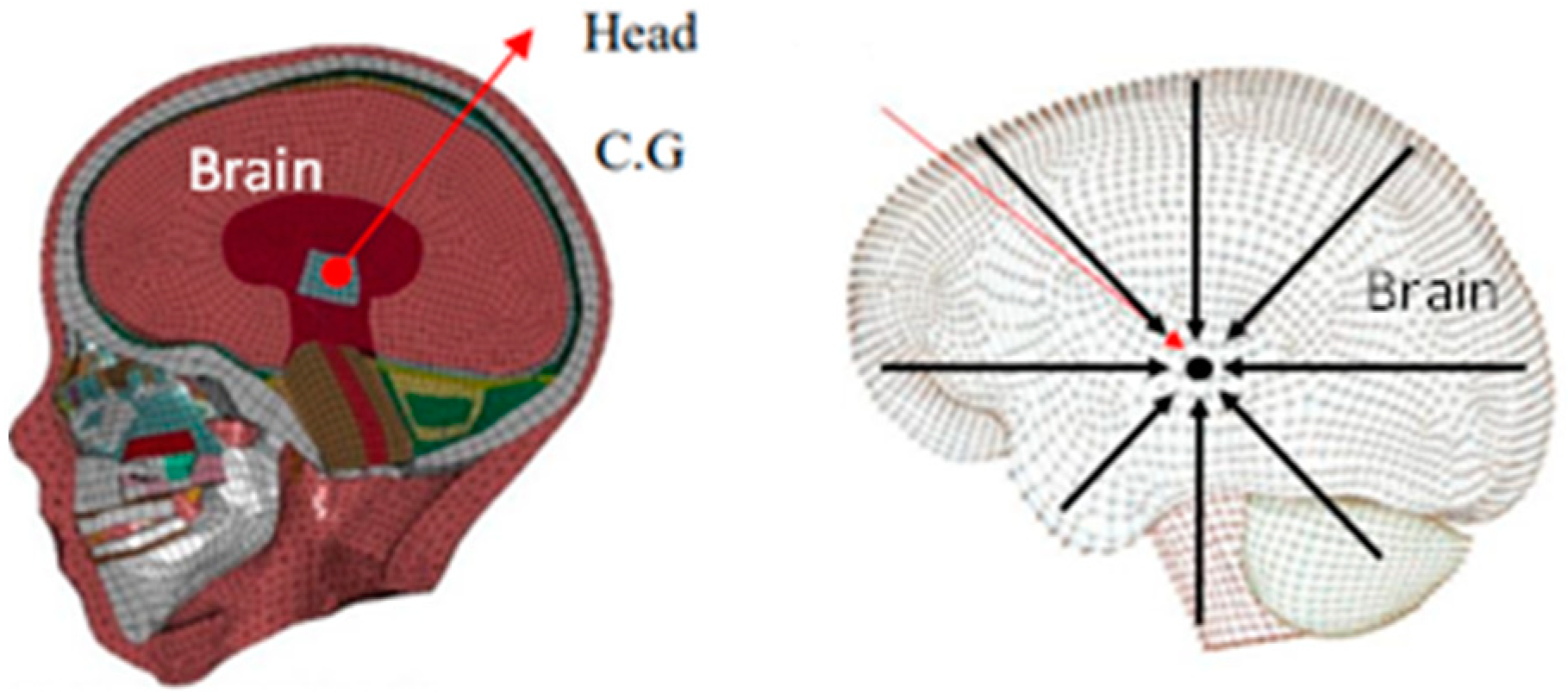
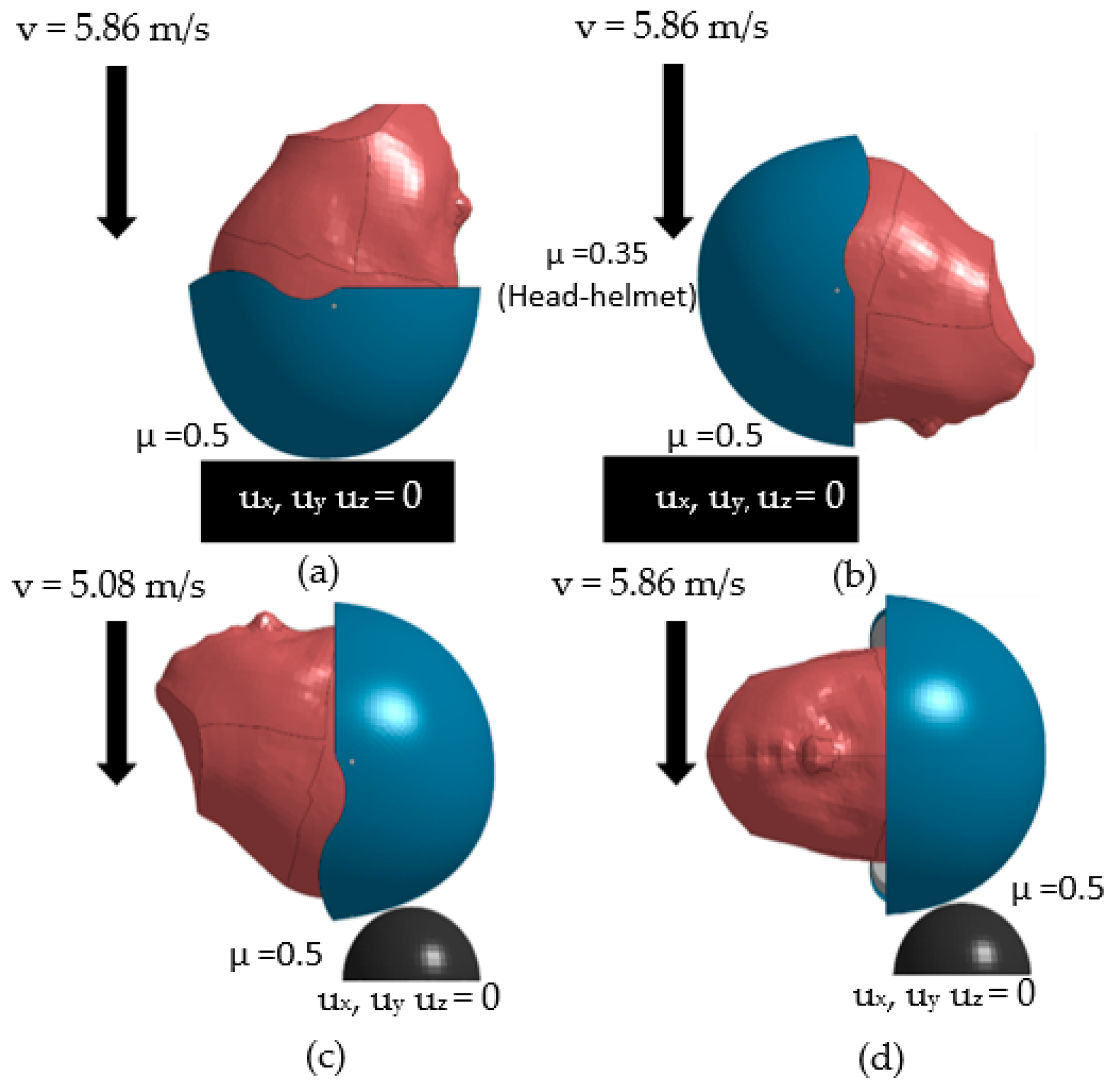
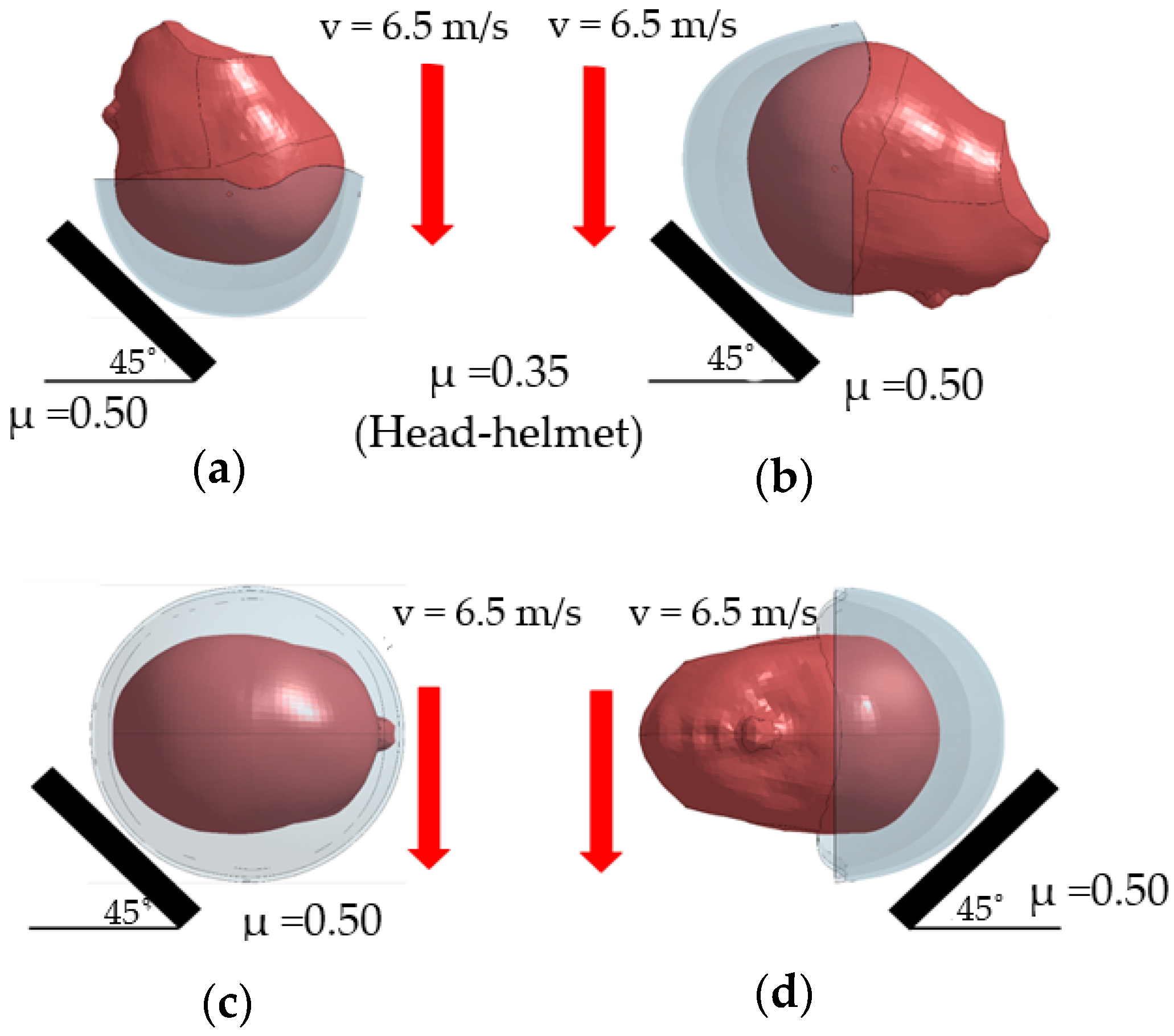

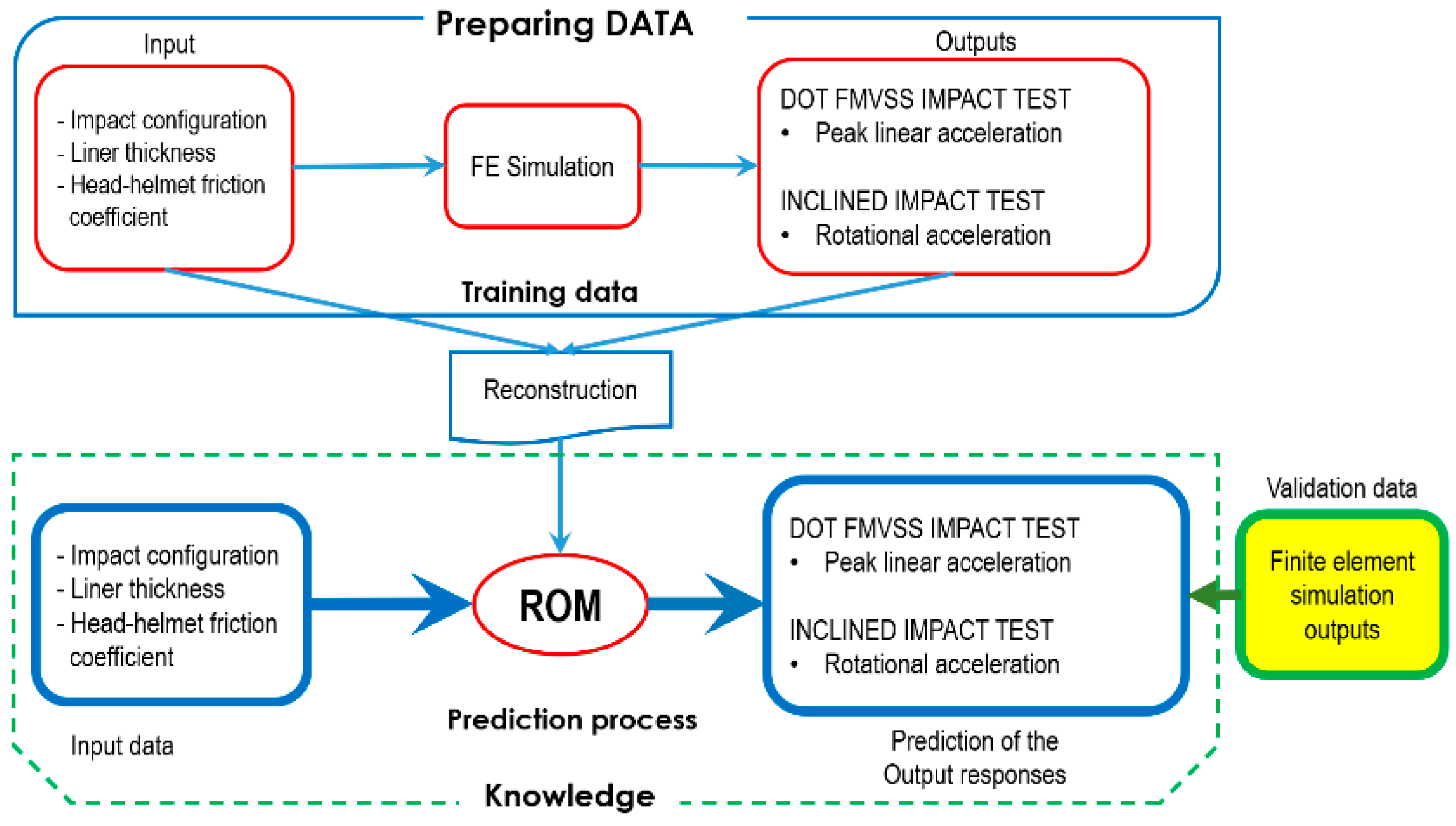
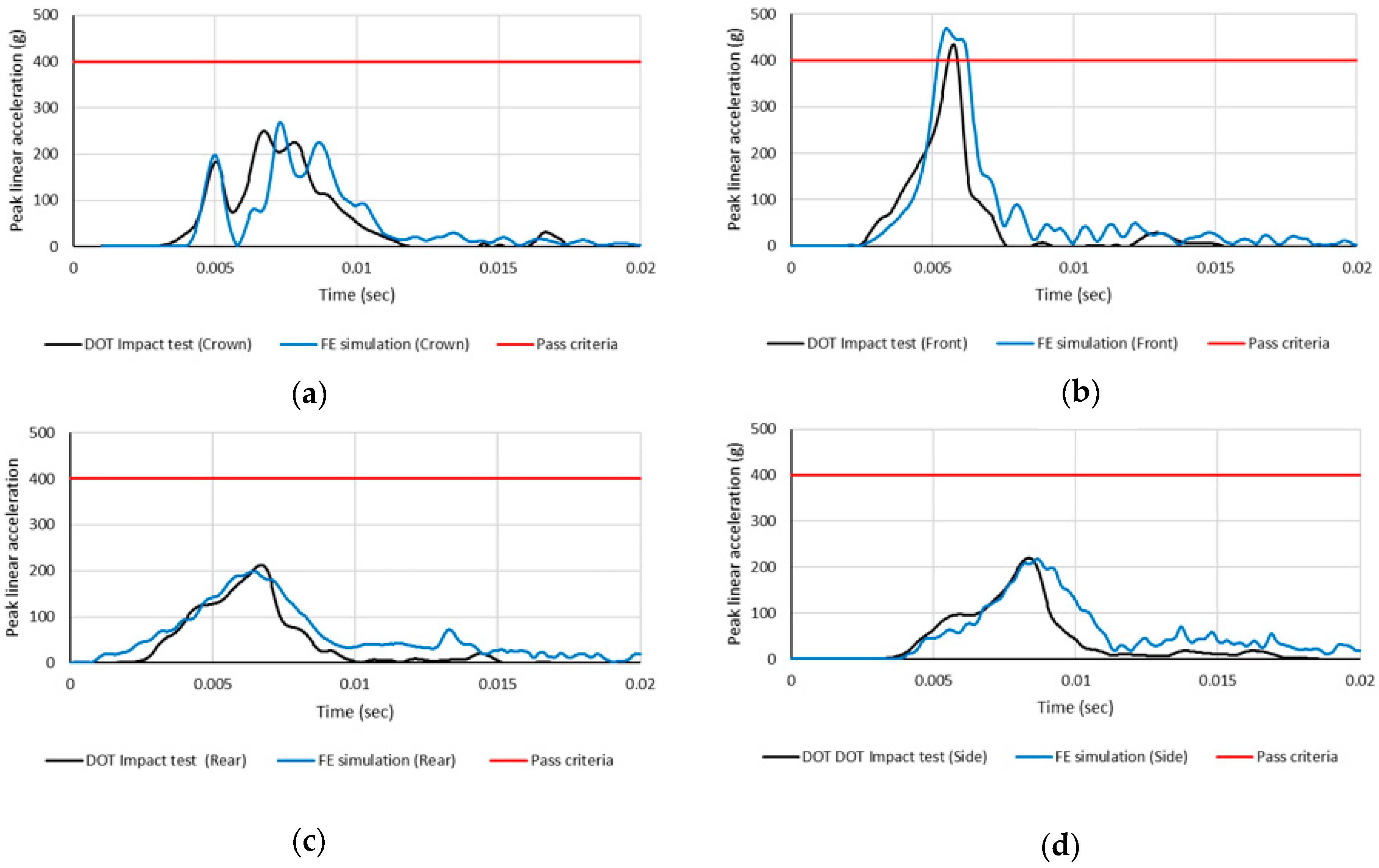
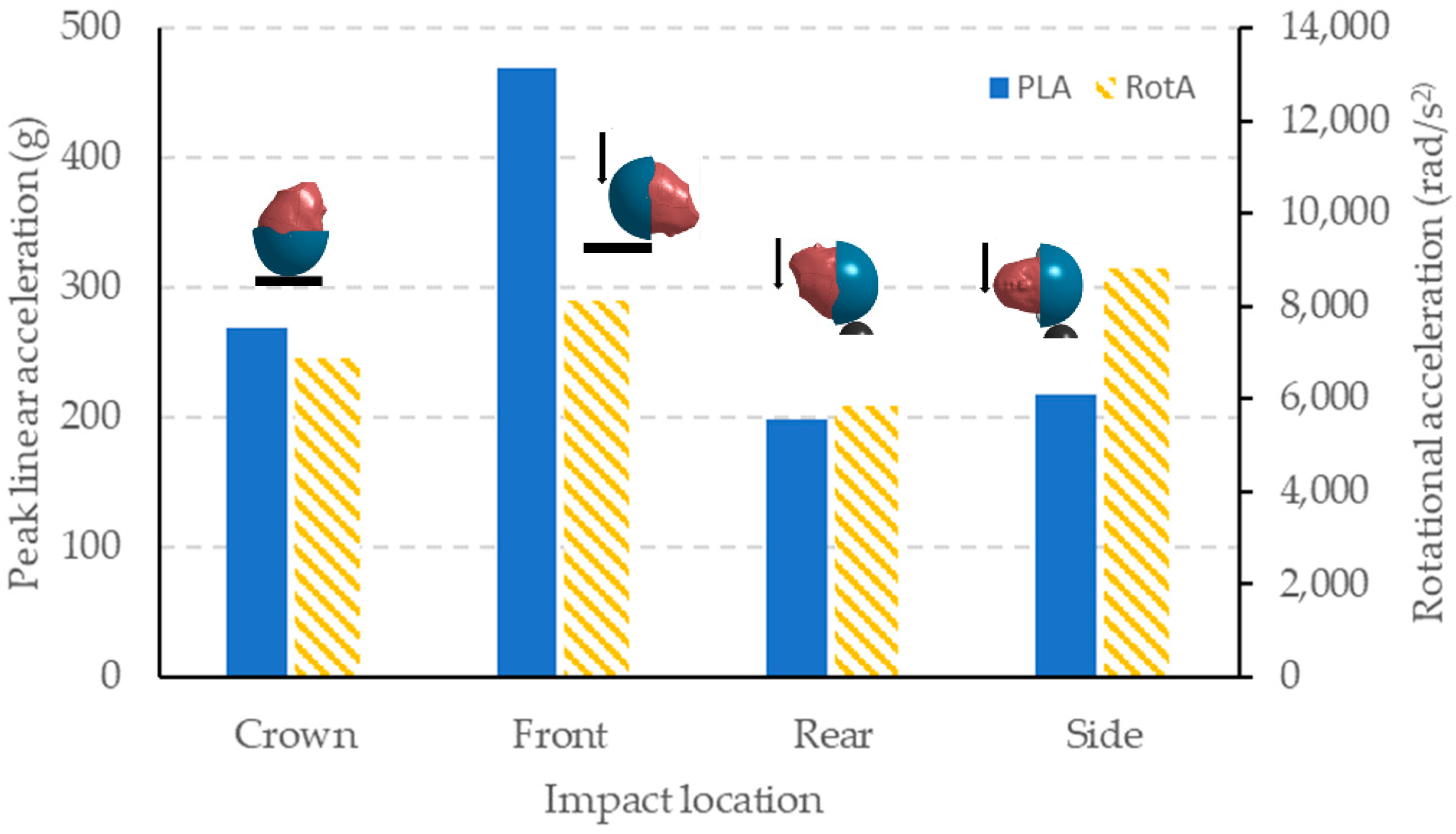
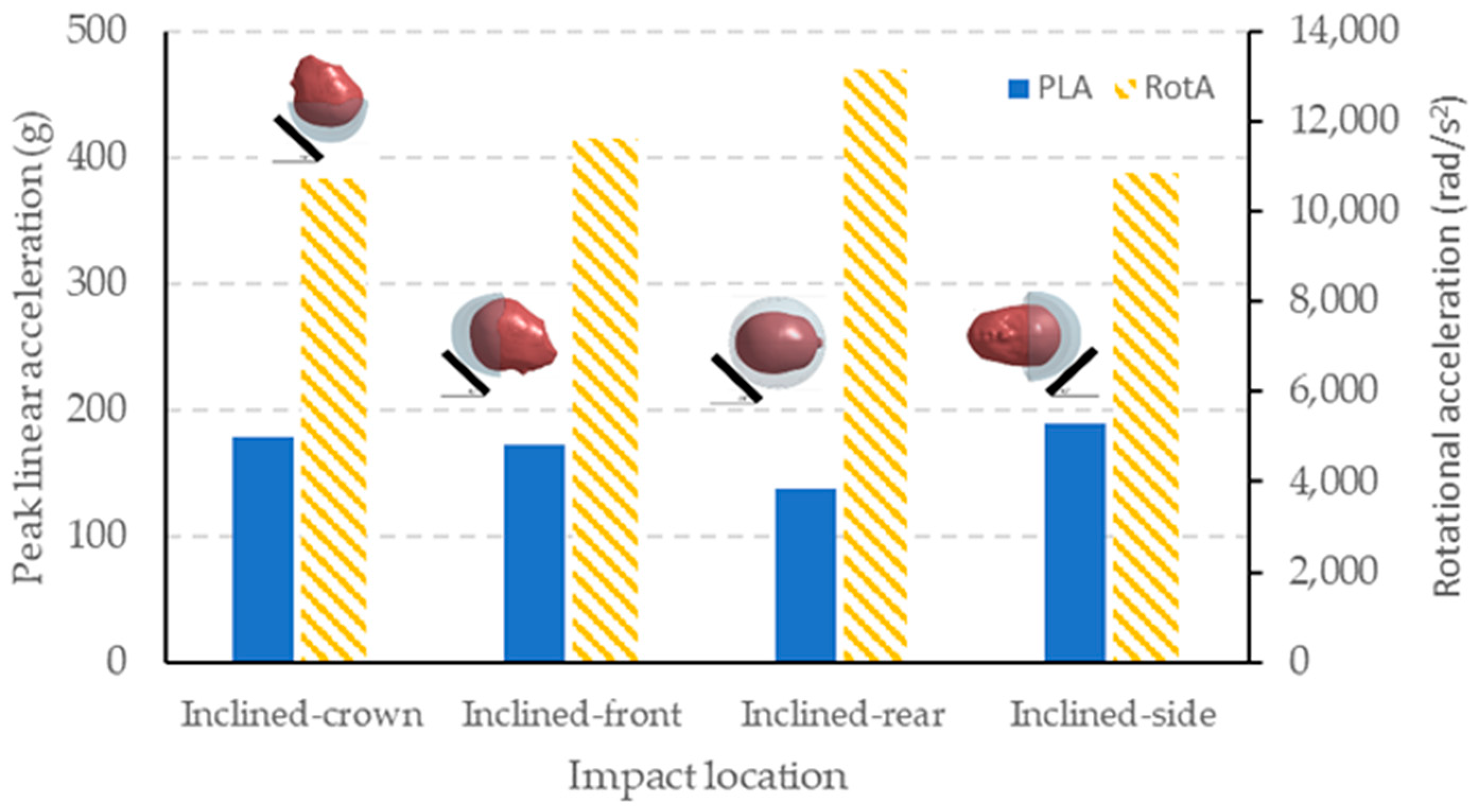

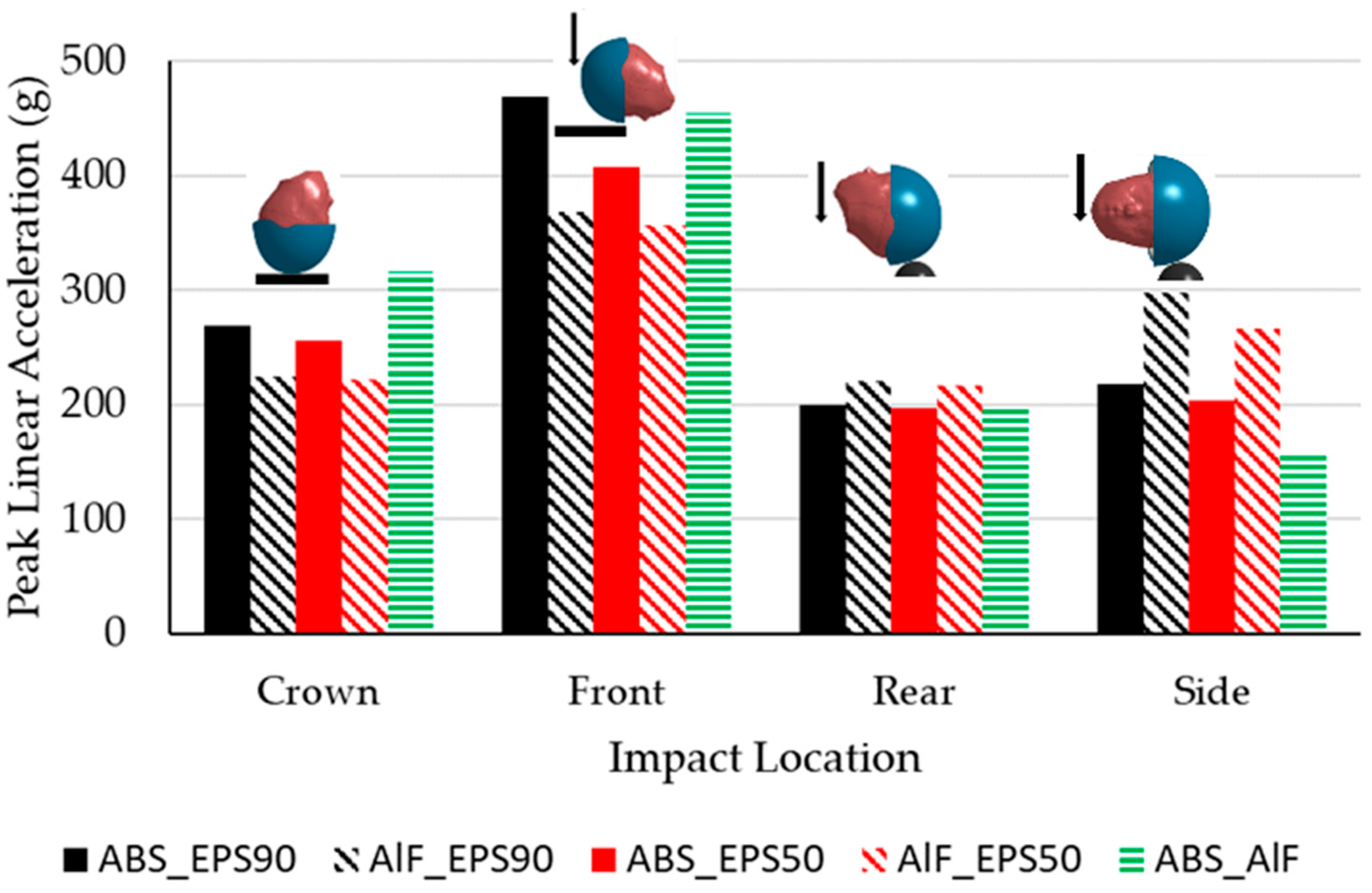




| Model Name | Outer Shell Material | Inner Liner Material | Weight (kg) |
|---|---|---|---|
| ABS_EPS90 | ABS | EPS 90 kg/m3 | 0.346 |
| ABS_EPS50 | ABS | EPS 50 kg/m3 | 0.317 |
| ALF_EPS90 | Al-foam | EPS 90 kg/m3 | 0.103 |
| ALF_EPS50 | Al-foam | EPS 50 kg/m3 | 0.073 |
| ABS_ALF | ABS | Al-foam | 0.413 |
| Model No. | 1 | 2 | 3 | 4 | 5 | 6 | 7 | 8 | 9 |
|---|---|---|---|---|---|---|---|---|---|
| Liner thickness (mm) | 10 | 10 | 10 | 15 | 15 | 15 | 20 | 20 | 20 |
| Head–helmet friction coefficient (µ) | 0.65 | 0.35 | 0.05 | 0.65 | 0.35 | 0.05 | 0.65 | 0.35 | 0.05 |
| Weight (kg) | 0.143 | 0.175 | 0.231 | ||||||
| Impact Location | Front | Side | Crown | Rear | Crown | Front | Rear | Side | Crown | Side | Front | Rear |
|---|---|---|---|---|---|---|---|---|---|---|---|---|
| Thickness (mm) | 10 | 10 | 10 | 10 | 15 | 15 | 15 | 15 | 20 | 20 | 20 | 20 |
| Friction coefficient | 0.2 | 0.2 | 0.5 | 0.5 | 0.2 | 0.2 | 0.5 | 0.5 | 0.2 | 0.2 | 0.5 | 0.5 |
| Inner Liner Thickness | Head–Helmet Friction Coefficient | Peak Linear Acceleration(g) | Rotational Acceleration (rad/s2) | ||||||
|---|---|---|---|---|---|---|---|---|---|
| Crown | Front | Rear | Side | Incl-Crown | Incl-Front | Incl-Rear | Incl-Side | ||
| 10 mm | 0.65 | 287.5 | 339.1 | 216.7 | 259.7 | 12,161 | 6738.5 | 10,312 | 8904.3 |
| 10 mm | 0.35 | 285.9 | 347 | 210.4 | 258.7 | 10,909 | 6821.1 | 9888.5 | 7971.8 |
| 10 mm | 0.05 | 278.5 | 324.9 | 124.8 | 234.4 | 6025.5 | 4564.3 | 5769.9 | 4281.9 |
| 15 mm | 0.65 | 254.9 | 252.9 | 169.9 | 158.9 | 10,885 | 7035.3 | 9336.4 | 7830.4 |
| 15 mm | 0.35 | 253.8 | 252.4 | 167.3 | 158.3 | 9370.1 | 6763.5 | 9087 | 7052.1 |
| 15 mm | 0.05 | 251.6 | 217.4 | 108.1 | 138.4 | 5511.6 | 3919.4 | 5598.6 | 4198.3 |
| 20 mm | 0.65 | 243.9 | 198.5 | 145.4 | 133.3 | 11,160 | 6798.9 | 9200.6 | 7035 |
| 20 mm | 0.35 | 243.3 | 196.8 | 141.9 | 132.3 | 9479.8 | 7059.1 | 8818.9 | 6204 |
| 20 mm | 0.05 | 248.7 | 152.2 | 100.9 | 126.9 | 5184.9 | 4047.2 | 6160.2 | 4188.2 |
| Impact Location | Head–Helmet Friction Coefficient (µ) | Liner Thickness (Th) |
|---|---|---|
| Inclined-crown | µ ≤ 0.23 | Th ≥ 10 mm |
| 0.23 < µ ≤ 0.28 | Th ≥ 13 mm | |
| 0.28 < µ ≤ 0.33 | Th ≥ 15 mm | |
| 0.33 < µ ≤ 0.36 | Th ≥ 17 mm | |
| Inclined-front | µ ≤ 0.65 | Th ≥ 10 mm |
| Inclined-rear | µ ≤ 0.21 | Th ≥ 10 mm |
| 0.21< µ ≤ 0.23 | Th ≥ 13 mm | |
| 0.23< µ ≤ 0.25 | Th ≥ 15 mm | |
| 0.25< µ ≤ 0.27 | Th ≥ 18 mm | |
| Inclined-side | µ ≤ 0.33 | Th ≥ 10 mm |
| 0.33< µ≤ 0.4 | Th ≥ 13 mm | |
| 0.4 < µ ≤ 0.5 | Th ≥ 15 mm | |
| 0.4 < µ ≤ 0.65 | Th ≥ 16 mm |
Publisher’s Note: MDPI stays neutral with regard to jurisdictional claims in published maps and institutional affiliations. |
© 2022 by the authors. Licensee MDPI, Basel, Switzerland. This article is an open access article distributed under the terms and conditions of the Creative Commons Attribution (CC BY) license (https://creativecommons.org/licenses/by/4.0/).
Share and Cite
Prasartthong, N.; Carmai, J. Investigation of the Effect of Child Helmet Design Parameters on Head and Brain Injuries Using Reduced-Order Modelling. Appl. Sci. 2022, 12, 8016. https://doi.org/10.3390/app12168016
Prasartthong N, Carmai J. Investigation of the Effect of Child Helmet Design Parameters on Head and Brain Injuries Using Reduced-Order Modelling. Applied Sciences. 2022; 12(16):8016. https://doi.org/10.3390/app12168016
Chicago/Turabian StylePrasartthong, Nattawood, and Julaluk Carmai. 2022. "Investigation of the Effect of Child Helmet Design Parameters on Head and Brain Injuries Using Reduced-Order Modelling" Applied Sciences 12, no. 16: 8016. https://doi.org/10.3390/app12168016






